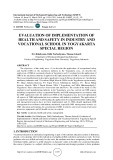
http://www.iaeme.com/IJMET/index.asp 1195 editor@iaeme.com
International Journal of Mechanical Engineering and Technology (IJMET)
Volume 10, Issue 03, March 2019, pp. 1195–1203, Article ID: IJMET_10_03_121
Available online at http://www.iaeme.com/ijmet/issues.asp?JType=IJMET&VType=10&IType=3
ISSN Print: 0976-6340 and ISSN Online: 0976-6359
© IAEME Publication Scopus Indexed
EVALUATION OF IMPLEMENTATION OF
HEALTH AND SAFETY IN INDUSTRY AND
VOCATIONAL SCHOOL IN YOGYAKARTA
SPECIAL REGION
Dwi Rahdiyanta, Didik Nurhadiyanto, Thomas Sukardi
Department of Mechanical Engineering Education
Faculty of Engineering, Yogyakarta State University, Yogyakarta, Indonesia
ABSTRACT
The objectives of this study were: (1) to describe the application of occupational safety
and health (OSH) in the machinery industry in the Yogyakarta area, (2) describe the
application
of OSH in vocational schools in
Yogyakarta
and (3) evaluate how the application of
OSH in the machinery industry if applied in the implementation of OSH in vocational schools.
The research method used is descriptive qualitative research. Research subjects are 3 production
machinery industries and 3 Vocational High Schools (VHSs) in the Yogyakarta region namely:
PT. Mega Andalan Kalasan, PT. Yogya Presisi Tehnikatama Industri, CV. Karya Hidup
Sentosa (Quick), VHSs 2 Depok Sleman, VHSs 2 Yogyakarta, and VHSs Muhammadiyah 3
Yogyakarta. Data collection uses observation and interviews. The results of the study:(1) The
machinery and manufacturing industry in the Yogyakarta area has carried out OSH aspects
including occupational safety, occupational health, and OSH management in accordance with
the OSH application rules for industry;(2)VHSs in the Yogyakarta area have not implemented
all aspects of OSH implementation in accordance with industry standards. The application of
occupational safety aspects is still lacking, the application of occupational health is still lacking,
and management aspects have not been implemented, and (3) VHSs should implement OSH
management in accordance with industry standards, especially OSH management, namely: (a)
OSH education and training, (b) socialization of OSH in schools, and (c) provision of personal
protective equipment, and (d) health services in schools.
Key words: vocational, health and safety, management.
Cite this Article: Dwi Rahdiyanta, Didik Nurhadiyanto, Thomas Sukardi, Evaluation of
Implementation of Health and Safety in Industry and Vocational School in Yogyakarta Special
Region, International Journal of Mechanical Engineering and Technology 10(3), 2019, pp.
1195–1203.
http://www.iaeme.com/IJMET/issues.asp?JType=IJMET&VType=10&IType=3
1. INTRODUCTION
Vocational education in mechanical engineering as part of the national education system in Indonesia,
played a very strategic role for the realization of a highly skilled workforce and ready to work. To form
graduates who are skilled and ready for the work, the students must have competency in the academic
field (hard skills), and have a noble character or character values (soft-skills). In vocational education,
the course of practice, is a subject which has a very important and strategic position to form graduates























